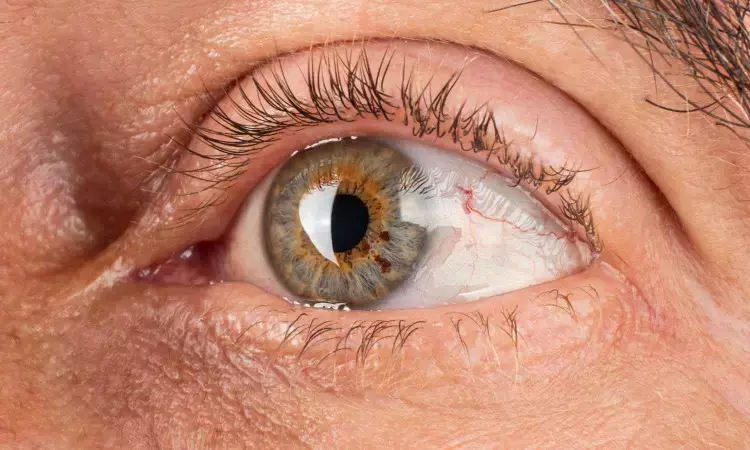- Home
- Medical news & Guidelines
- Anesthesiology
- Cardiology and CTVS
- Critical Care
- Dentistry
- Dermatology
- Diabetes and Endocrinology
- ENT
- Gastroenterology
- Medicine
- Nephrology
- Neurology
- Obstretics-Gynaecology
- Oncology
- Ophthalmology
- Orthopaedics
- Pediatrics-Neonatology
- Psychiatry
- Pulmonology
- Radiology
- Surgery
- Urology
- Laboratory Medicine
- Diet
- Nursing
- Paramedical
- Physiotherapy
- Health news
- Fact Check
- Bone Health Fact Check
- Brain Health Fact Check
- Cancer Related Fact Check
- Child Care Fact Check
- Dental and oral health fact check
- Diabetes and metabolic health fact check
- Diet and Nutrition Fact Check
- Eye and ENT Care Fact Check
- Fitness fact check
- Gut health fact check
- Heart health fact check
- Kidney health fact check
- Medical education fact check
- Men's health fact check
- Respiratory fact check
- Skin and hair care fact check
- Vaccine and Immunization fact check
- Women's health fact check
- AYUSH
- State News
- Andaman and Nicobar Islands
- Andhra Pradesh
- Arunachal Pradesh
- Assam
- Bihar
- Chandigarh
- Chattisgarh
- Dadra and Nagar Haveli
- Daman and Diu
- Delhi
- Goa
- Gujarat
- Haryana
- Himachal Pradesh
- Jammu & Kashmir
- Jharkhand
- Karnataka
- Kerala
- Ladakh
- Lakshadweep
- Madhya Pradesh
- Maharashtra
- Manipur
- Meghalaya
- Mizoram
- Nagaland
- Odisha
- Puducherry
- Punjab
- Rajasthan
- Sikkim
- Tamil Nadu
- Telangana
- Tripura
- Uttar Pradesh
- Uttrakhand
- West Bengal
- Medical Education
- Industry
Smart eye patch uses fluorescence to monitor eye health, finds research

Recently, Prof. JIANG Changlong's research team from the Institute of Solid State Physics, the Hefei Institutes of Physical Science of the Chinese Academy of Sciences, used multi-emission metal organic framework hydrogel (Eu-Dy MOF gel) to construct a non-invasive wearable eye patch fluorescence sensor, combined with the color recognition function of a smartphone to analyze and monitor lysozyme in tears.
The research results were published in Analytical Chemistry.
Lysozyme, often called "the body's own antibiotic," plays a crucial role in protecting the eyes from infection. As an important biomarker for various eye diseases, monitoring its levels in tears can offer valuable insights into eye health. However, traditional methods for detecting lysozyme are often invasive or require complex equipment.
In this study, the research team proposed a non-invasive fluorescent visualization detection method, expanding the application range of eye patch fluorescent sensors: First, the functionalized Eu-Dy MOF gel probes integrated into the eye patch sensors are used as sensing units. Tear fluids secreted by the eyes are collected via the eye patches applied to the skin beneath the eyes. The color signal generated by the sensing area on the eye patch under ultraviolet light are then captured using the camera function of a smartphone, and analyzed using color recognition software on the device.
The researchers point to the "antenna effect" as the reason for using MOF materials. In this mechanism, organic ligands in the MOF absorb light energy and transfer it to lanthanide ions like Eu³⁺ and Dy³⁺, which then emit visible fluorescence. This efficient energy transfer makes MOF gels ideal for sensitive optical sensing.
In the presence of lysozyme, the Eu-Dy MOF gel forms complexes with the protein, leading to a quenching of blue fluorescence through static quenching and local electron transfer. The system demonstrated a detection limit as low as 1.5 nanomolar, making it highly sensitive for real-time monitoring.
"Our finding holds great potential for non-invasive detection of lysozyme in tears, promoting the widespread application of functionalized MOF fluorescent sensors in personal health monitoring, disease early warning, diagnosis and treatment fields," said Prof. Changlong Jiang.
Reference:
Lei Pan,Fan Yang,Xiaohui Kang,Qipeng Zhang,Changlong Jiang, Rare Earth Ion-Induced Functionalized Fluorescent MOF Hydrogel Patches for Monitoring Lysozyme in Tears, Analytical Chemistry, https://doi.org/10.1021/acs.analchem.5c00346
Dr Kamal Kant Kohli-MBBS, DTCD- a chest specialist with more than 30 years of practice and a flair for writing clinical articles, Dr Kamal Kant Kohli joined Medical Dialogues as a Chief Editor of Medical News. Besides writing articles, as an editor, he proofreads and verifies all the medical content published on Medical Dialogues including those coming from journals, studies,medical conferences,guidelines etc. Email: drkohli@medicaldialogues.in. Contact no. 011-43720751


